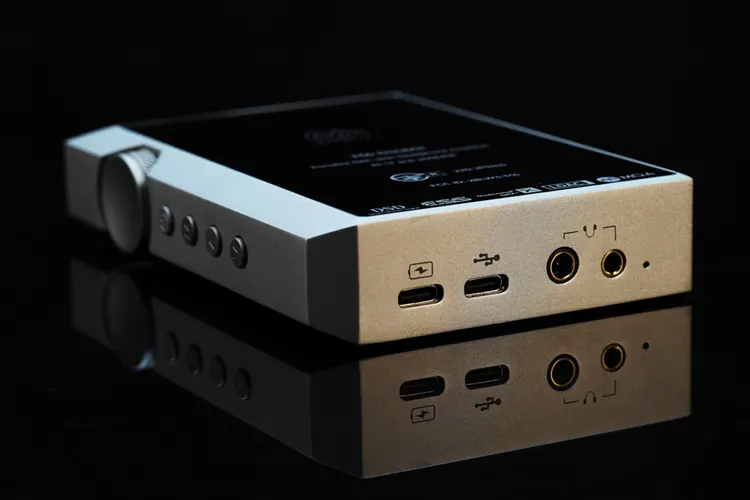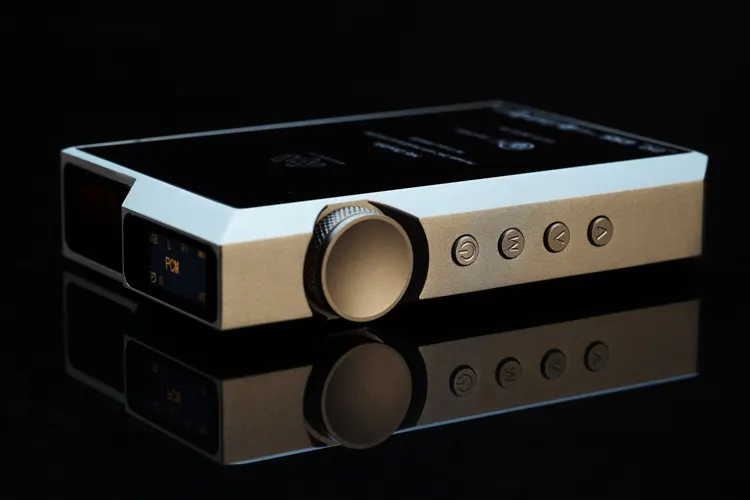Blog
MUSE HiFi M6 Double Review — Headfonics

Marcelo reviews the MUSE HiFi M6 Double, a new dual-mode transistor and JAN6418 tube portable headphone DAC/amp with a Neon Nixie IN-7 tube display.
Disclaimer: This sample was sent to me in return for my honest opinion. Headfonics is an independent website that does not have any affiliate links. I thank HiFiGO and MUSE HiFi for this opportunity.
Click here to read more about other HiFiGO and MUSE products previously reviewed on Headfonics.
This article follows our current scoring guidelines, which you can read in more detail here.
MUSE HiFi is a memorable brand to me because the first review I did for Headfonics was of the MUSE HiFi M5 Ultra, a really nice-sounding tube hybrid Bluetooth DAC amplifier.
I am now stoked that they released a Limited Edition Bluetooth DAC amplifier, the MUSE HiFi M6 Double, which sells for $399.
You may ask why they named it Double? It’s because it refers to the use of IN-17, the smallest Pixie display tube with double digits, as the volume indicator for the M6 Double, combined with two JAN 6418, the smallest audio tube, hence the name Double.
What makes the M6 Double truly special is that these IN-17 Pixie tubes are so rare that they must be sourced primarily from Russia and some from Europe.
These IN-17s were produced between 1960 and 1970, before LED displays became available. MUSE HiFi managed to procure 2,200 tubes and was told by the suppliers that these are the last remaining stocks, making MUSE HiFi the world’s largest single stockist of the IN-17.
Additionally, MUSE HiFi made the extra effort to make the IN-17 Pixie tubes work with the M6 Double by using a customized power supply and control system.
This tube requires 170 Volts, which is much higher than the voltage needed for LEDs. And all the tubes are mounted on a shock-absorbing platform.
Due to the rarity of the IN-17 tube, MUSE HiFi only makes 1000 units of the M6 Double, making this product a Limited Edition. My review sample is numbered 0000/1000.
But enough about the display tube, and ask how the M6 Double sounds? And how does it compare to other Bluetooth DAC amplifiers, including the MUSE HiFi M5 Ultra and the SMSL DS20? Let’s find out.


Features
The M6 Double features the latest DAC from ESS SABRE, an ES9039Q2M DAC chip, customized to complement the tube amplifier section during tube mode operation. The also uses two JAN 6418 mini audio vacuum tubes for the tube output mode.
Aside from the DAC chip, battery capacity, and tubes, MUSE HiFi has never published other specifications, including the power output, at least not at the time of this writing.
This is similar to their previous model, the MUSE HiFi M5 Ultra. However, MUSE HiFi indicated that they increased the power output on both the 3.5mm and 4.4mm output jacks to fully handle high-impedance headphones.
I would estimate M6 Double’s 4.4mm output to be around 400mW or more, as it is noticeably more powerful than its predecessor, the M5 Ultra.
The M6 Double also drives my high-impedance headphones to loud volumes with good sound quality, further cementing my estimate of its power output. However, it is not as powerful as my FiiO M15s DAP, which has a maximum output of 1,200 mW.
M6 Double supports wireless Bluetooth connection up to aptX and LDAC codecs, and audio decoding for PCM, DSD, and MQA.


Design
I like the futuristic mecha design characterized by its angular and faceted looks. I also appreciate the inclusion of a big metal knob volume control and the perforation on the left side, which serves as vents for the tubes and for display.
The chassis is fully made of CNC-machined aluminum alloy, with tempered glass sandwiched in the front and back. All the controls are on the right side, comprising a knob and four buttons.
All the I/Os are at the bottom, consisting of a USB charging port, USB audio port, 3.5mm output jack, and 4.4mm output jack.
There is a clear portion in the tempered glass at the front allowing us to see the PCB; however, the back only has an opaque black tempered glass, which is printed with texts and logos.
At the top, you can see the 1-inch screen indicating the operating condition of the M6 Double, with the IN-17 Pixie tube nicely placed behind a glass in another window beside the screen.
M6 Double is slightly bigger as far as battery-powered Bluetooth DAC amplifiers go; it measures 121.2 x 81.3 x 24.5mm and weighs 285 grams.


Display
MUSE HiFi customized the one-inch display at the top to show the Headfonics logo briefly when turned on, then switches to regular mode, displaying the adjustable functions and the working condition of the M6 Double.
The display shows the input mode, gain, filter, battery level, amplification mode, and shutdown timer, all of which can be controlled and adjusted using the buttons on the right side of the M6 Double. It also shows the codec, or digital audio signal type, at the center.


I/O
All inputs and outputs are neatly located at the bottom. From left to right are the 3.5mm output jack, 4.4mm output jack, USB-C data/audio port, and the USB-C charging port.
There is no line-level output function on the M6 Double. However, that feature is not nearly as important as the USB-C charging port.


Controls
All the controls are on the right side. From top to bottom, there is the volume knob, followed by the power button, which also functions as the display off button.
Below that is the M button, which allows you to cycle through functions on the screen, adjustable using the up and down buttons. These buttons also serve as skip forward and backward for the music.
There is a notable lack of a play pause button. But this is not a deal breaker for me, as I mainly use the controls to adjust the settings on the M6 Double and control the music exclusively on the music player.
Battery & Charging
The M6 Double features a 4500mAh battery, which lasted around 13 hours during my testing. This was with USB input using an IEM with a 4.4mm cable, playing at my normal listening volume, which isn’t bad at all considering my usual listening level is quite loud.
It took me about 4.5 hours to fully charge the M6 Double. However, I noticed that at the 2-hour mark, the battery indicator was already full, while the screen kept indicating it was charging. I waited it out, and the charging indicator only stopped at about 4.5 hours.
I’m happy to report that, although the M6 Double doesn’t have fast charging, the chassis never got hot. It stayed only faintly warm during use and charging, which is good news if you want to prolong the battery’s lifespan.


Packaging & Accessories
The packaging is simple and practical, yet it has a class and sophistication in its design. It is a hard black box with the M6 Double photo at the front and some texts all around, which measures 170 x 110 x 90 mm.
There is another black hard box that slides out from the side, which contains the M6 Double, a leather protective case, a manual, a USB-C to A adapter, a long USB-A to C cable, and two short and straight USB-C to C connectors. I do wish one of the short USB-C connectors were angled, but having two is okay, too.


Sound Impressions
For critical listening and comparisons, I mainly used my Android phone and the FiiO M15S DAP as sources. For IEMs and headphones, I used the DUNU Falcon Ultra, Kiwi Ears Astral, the MOONDROP Horizon, and Sennheiser’s HD 6XX headphones.
I used PowerAmp and UAPP music player Apps in their default audio settings without filters, EQ, and audio enhancement. I switched between low, medium, and high gain depending on the pairing and the default F1 filter in the M6 Double.
All the comparisons are done with the M6 Double in its transistor mode.
Summary
Before seriously listening to the M5 Double, I spent over 30 hours in transistor mode and 6 hours in vacuum tube mode of burn-in, while testing battery life and checking charging times. I noticed a smoother sound with increased soundstage after the burn-in, especially in the tube mode.
That said, in the transistor mode, the tonality is neutral, featuring extended subbass and treble, and without any emphasis on frequency regions that might color the sound; in other words, the M6 Double has a flat frequency response.
Bass has impactful, punchy, and tight characteristics. Yet, it never shies away from supplying tremendous amounts of subbass energy, resulting in a fast, articulate, and textured sound with a lot of power in reserve for the lowest frequencies.
The midrange is neutral, smooth, and flat, without any added characteristics like warmth or emphasis in the upper midrange, which brings the instrument’s presence forward.
The M6 Double midrange is accurate. The same can be said for the treble; it is neutral and smooth with no peakiness or coloration.
M6 Double offers good resolution and detail retrieval, allowing me to hear many macro and micro details in the music, making me feel like I’m hearing everything and not missing anything. The micro details are not quite as good as the best I’ve listened to, though.
In the vacuum tube mode, it is almost the same as the transistor mode except that the tiny leading edges of the transients are slightly rounded, the bass becomes slightly more boomy, and the resolution decreases somewhat. Yet, the treble extension remains neutral and flat, never becoming darker.
Switching to the vacuum tube mode results in an analog-style sound signature where the ultimate resolution is slightly sacrificed for a denser and more engaging sound that many people enjoy, including me.


Coloration
Well, aside from the vacuum tube mode sound coloration described above, which is a deliberate design choice, there is not much coloration that can be heard in the transistor mode. M6 Double is as coloration-free as a DAC amplifier can be.
However, if held at gunpoint to tell the sound coloration of the M6 Double, I would say the presentation of sound leans towards the relaxed side.
Staging & Dynamics
Thanks to M6 Double’s clean and tight sound, there are no issues when it comes to soundstage. M6 Double’s soundstage is large in both transistor and vacuum tube modes, offering nice width and height. Due to its clean background rendition, it also has very good depth.
M6 Double is never short in supply of spaciousness. There seems to be a good space between the instruments and the listener, and between the instruments and the singer.
Depending on the headphones or IEMs used, the M6 Double could sound spatially natural, giving the listener good sound immersion.
Dynamically, M6 Double is in no short supply as well; regardless of the headphones or the IEMs used, M6 Double never sounds boring, lethargic, or dead. It sounds reasonably energetic.
There is a good rendition of the macro and the micro dynamics, thanks to its robust power output.
I hear the sudden loudness in the music, like snaps of loud snare drums (macro dynamics) and the variations in how the drummer hits the closed hi-hat (micro dynamics), but the latter isn’t quite as good as the best I’ve heard.
Click on page 2 below for my recommended pairings, wireless performance, and selected comparisons.













